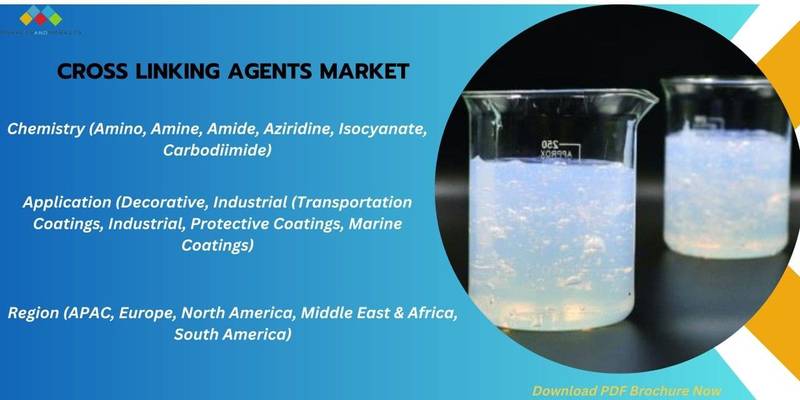The According to a market research report, the “Cross Linking Agents Market by Chemistry (Amino, Amine, Amide, Aziridine, Isocyanate, Carbodiimide), Application (Decorative, Industrial (Transportation Coatings, Industrial, Protective Coatings, Marine Coatings), & Region – Global Forecast to 2028″, is projected to reach USD 13.6 billion by 2028, at a CAGR of 6.5% from USD 9.9 billion in 2023. The increasing demand for high-performance materials in various industries, such as industrial & decorative coatings, is driving the need for improved material properties achieved through cross-linking. The growing focus on sustainability and environmentally friendly solutions is fuelling the demand for cross-linking agents that offer reduced environmental impact. Additionally, advancements in technology and research have led to the development of new and more efficient cross-linking agents with enhanced compatibility and versatility, further driving the market’s growth.
Download PDF Brochure: https://www.
Browse
- 115 Market data Tables
- 46 Figures
- 200 Pages and in-depth TOC on “Cross Linking Agents Market – Global Forecast to 2028”
This report also provides a comprehensive analysis of the companies listed below:
The key global players in the Cross Linking Agents market include BASF SE (Germany), Covestro AG (Germany), Allnex Group (Germany), Evonik Industries (Germany), Hunstman
Merger & acquisitions, investments & expansions, partnerships & collaborations, and new product developments are some of the major strategies adopted by these key players to enhance their positions in the Cross Linking Agents market.
Recent Developments in Cross Linking Agents Market Industry
- In 2023, BASF announced to expand its existing capacity of isocyanate. The company will increase production capacity to approximately 600,000 metric tons per year.
- In May 2021, Wanhua Chemical announced that Wanhua Chemical (Ningbo) Co., Ltd. plans to implement the MDI/HDI technical transformation and capacity expansion integration project in the existing plant. Wanhua Chemical also plans to build a new 280,000-ton/year modified MDI production unit, with a total capacity of 300,000 tons/year Modified MDI production capacity.
Request Sample Pages: https://www.
Based on Chemistry, the Cross linking agent market is segmented into amino, amine, amide, aziridine, carbodiimide, isocyanate, and others. Amino chemistry segment to dominate the cross linking agent market during the forecast period. Amino segment offers excellent cross-linking capabilities, strong bonding properties and are compatible with a wide range of polymers. Amino compounds, such as amino resins and amino silanes, offer improved mechanical properties, thermal stability, and adhesion, making them ideal for various applications in coatings, adhesives, and sealants. Their versatility and wide industry applicability contribute to the amino segment’s dominance in the cross-linking agent market’s chemistry segment.
Based on applications, the cross linking market is segmented into decorative and industrial. Industrial application segment to dominate the cross linking agent market during the forecast period. The industrial sector encompasses a wide range of industries, including automotive, construction, electronics, and packaging, all of which extensively utilize cross-linked materials. Cross-linking agents enhance the performance and durability of materials in these sectors, providing benefits such as improved mechanical properties, resistance to chemicals and weathering, and increased product lifespan. The high demand for cross-linked materials in industrial applications, driven by factors like product quality, reliability, and regulatory compliance, contributes to the dominance of the industrial segment in the cross-linking agent market’s application segment.
Asia Pacific is the largest and fastest-growing market for cross linking agents. The Asia Pacific region has been experiencing significant industrial and economic growth, which drives demand for various products and materials that rely on crosslinkers. Rapid urbanization in countries like China, India, and Southeast Asian nations has led to increased infrastructure development and construction activities. Crosslinkers are commonly used in adhesives, sealants, and coatings for building and infrastructure projects. The automotive sector in the Asia Pacific region has been booming, with a growing middle class and increased consumer spending. Crosslinkers are used in the manufacturing of automotive parts, coatings, and adhesives, supporting the growth of this industry.
Inquire Now: https://www.
Download Reports PDF Brochure of Now Trending in APAC Region

